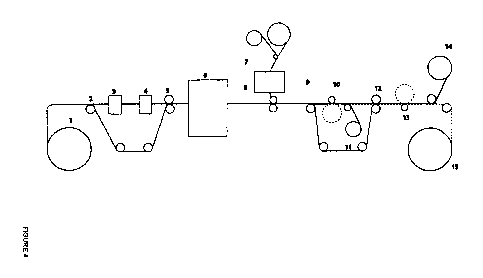Some of the information on this Web page has been provided by external sources. The Government of Canada is not responsible for the accuracy, reliability or currency of the information supplied by external sources. Users wishing to rely upon this information should consult directly with the source of the information. Content provided by external sources is not subject to official languages, privacy and accessibility requirements.
Any discrepancies in the text and image of the Claims and Abstract are due to differing posting times. Text of the Claims and Abstract are posted:
| (12) Patent Application: | (11) CA 2769172 |
|---|---|
| (54) English Title: | SELF ADHESIVE LABEL- ENVELOPE (SEALED IN ROLL) |
| (54) French Title: | ETIQUETTE-ENVELOPPE AUTOADHESIVE (SCELLEE EN ROULEAU) |
| Status: | Deemed Abandoned and Beyond the Period of Reinstatement - Pending Response to Notice of Disregarded Communication |
| (51) International Patent Classification (IPC): |
|
|---|---|
| (72) Inventors : |
|
| (73) Owners : |
|
| (71) Applicants : |
|
| (74) Agent: | BLAKE, CASSELS & GRAYDON LLP |
| (74) Associate agent: | |
| (45) Issued: | |
| (86) PCT Filing Date: | 2010-07-29 |
| (87) Open to Public Inspection: | 2011-02-03 |
| Availability of licence: | N/A |
| Dedicated to the Public: | N/A |
| (25) Language of filing: | English |
| Patent Cooperation Treaty (PCT): | Yes |
|---|---|
| (86) PCT Filing Number: | PCT/GR2010/000034 |
| (87) International Publication Number: | WO 2011012911 |
| (85) National Entry: | 2012-01-25 |
| (30) Application Priority Data: | ||||||
|---|---|---|---|---|---|---|
|
The product Self-adhesive Label - Envelope (sealed in a roll) (3) is a self adhesive envelope in roll (1) that includes a sticker or a simple card (2) completely enclosed, that does not have any contact with the exterior environment of the self-adhesive envelope. The production of the product The product Self-adhesive Label - Envelope (sealed in a roll) (3) is produced with a single pass on a printing machine of self adhesive labels in a roll (4) which apart from the printing stations has the possibility of opening the self-adhesive material two times - one for printing and destroying the adhesive and one for inverted (5) and internal cutting, at least two cylindrical stations of die cutting [for right and inverted cutting (5) (the station for inverted cutting should also have a rewinding unit for the waste) and a station for cold lamination with a unit for the destruction of the adhesive.
L'invention porte sur une étiquette-enveloppe autoadhésive (scellée en un rouleau) (3), qui est une enveloppe autoadhésive en rouleau (1) qui comprend une étiquette ou une carte simple (2) complètement enfermée, qui n'a aucun contact avec l'environnement extérieur de l'enveloppe autoadhésive. La production du produit d'enveloppe-étiquette autoadhésive (scellée en un rouleau) (3) est produite avec un passage unique sur une machine d'impression d'étiquettes autoadhésives dans un rouleau (4), qui, en dehors des stations d'impression, a la possibilité d'ouvrir le matériau autoadhésif deux fois - une fois pour l'impression et la destruction de l'adhésif et une fois pour une coupe inversée (5) et interne, au moins deux stations cylindriques de coupe par matriçage pour la coupe droite et inversée (5) (la station pour la coupe inversée devrait également avoir une unité de réenroulage pour les déchets) et une station pour la stratification à froid avec une unité pour la destruction de l'adhésif.
Note: Claims are shown in the official language in which they were submitted.
Note: Descriptions are shown in the official language in which they were submitted.

2024-08-01:As part of the Next Generation Patents (NGP) transition, the Canadian Patents Database (CPD) now contains a more detailed Event History, which replicates the Event Log of our new back-office solution.
Please note that "Inactive:" events refers to events no longer in use in our new back-office solution.
For a clearer understanding of the status of the application/patent presented on this page, the site Disclaimer , as well as the definitions for Patent , Event History , Maintenance Fee and Payment History should be consulted.
| Description | Date |
|---|---|
| Application Not Reinstated by Deadline | 2016-07-29 |
| Time Limit for Reversal Expired | 2016-07-29 |
| Deemed Abandoned - Failure to Respond to Maintenance Fee Notice | 2015-07-29 |
| Inactive: Abandon-RFE+Late fee unpaid-Correspondence sent | 2015-07-29 |
| Inactive: Cover page published | 2012-03-29 |
| Inactive: Notice - National entry - No RFE | 2012-03-19 |
| Inactive: IPC assigned | 2012-03-07 |
| Application Received - PCT | 2012-03-07 |
| Inactive: First IPC assigned | 2012-03-07 |
| Inactive: IPC assigned | 2012-03-07 |
| Inactive: IPC assigned | 2012-03-07 |
| Inactive: IPC assigned | 2012-03-07 |
| National Entry Requirements Determined Compliant | 2012-01-25 |
| Application Published (Open to Public Inspection) | 2011-02-03 |
| Abandonment Date | Reason | Reinstatement Date |
|---|---|---|
| 2015-07-29 |
The last payment was received on 2014-07-02
Note : If the full payment has not been received on or before the date indicated, a further fee may be required which may be one of the following
Please refer to the CIPO Patent Fees web page to see all current fee amounts.
| Fee Type | Anniversary Year | Due Date | Paid Date |
|---|---|---|---|
| MF (application, 2nd anniv.) - standard | 02 | 2012-07-30 | 2012-01-25 |
| Basic national fee - standard | 2012-01-25 | ||
| MF (application, 3rd anniv.) - standard | 03 | 2013-07-29 | 2013-06-21 |
| MF (application, 4th anniv.) - standard | 04 | 2014-07-29 | 2014-07-02 |
Note: Records showing the ownership history in alphabetical order.
| Current Owners on Record |
|---|
| ANGELIKI TZANNINI |
| Past Owners on Record |
|---|
| None |